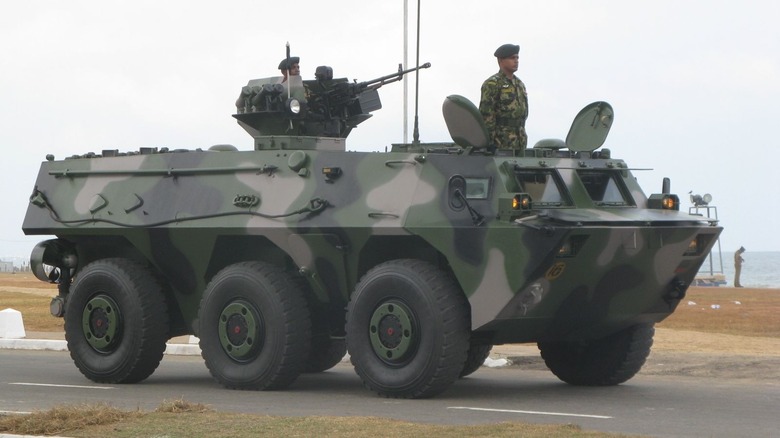ZSL90 Vs. ZSL92: What's The Difference Between These Armored Personnel Carriers?
In the wake of World War II, when tanks were pivotal in the Pacific Theater, the Chinese People's Liberation Army (PLA) relied heavily on the Soviet Union to produce much of its heavy equipment. Even as late as the 1960s, the PLA worked closely with the Soviets to develop and manufacture the Jiefang CA-30, a 6x6 military truck based on the CA-10, which was inspired by the Soviet's ZIS-150.
It wasn't until 1984 that the PLA would tackle the production of its own armored vehicle, already possessing Soviet jets that America feared. The family of wheeled amphibious military infantry fighting vehicles (IFV), designated WZ-551, included several different variants, many of which never entered full production. The most notable of them were the Type 90 (ZSL-90) prototype and the Type 92 (ZSL-92) production variant.
Having been developed off the concepts introduced in the Type 90, the ZSL-92 featured several improvements that helped it be a more viable option for the PLA. Produced by the China North Industries Group Corporation Limited (Norinco), the Type 90 saw limited production in the 1980s before the PLA voiced its dissatisfaction, leading to a few much-needed upgrades in the design and differences that made the Type 92 a better armored IFV than its prototype counterpart.
[Featured image by Slick-o-Bot via Wikimedia Commons | Cropped and scaled | CC BY-SA 3.0]
Improved propulsion for cross-country travel
Though official details regarding the original WZ-551 prototypes are slim, the Type 90 was said to be powered by a water-cooled engine. In modern consumer vehicles, water-cooled engines tend to be better at cooling off the propulsion system, as a continuous stream of water runs through it regardless of if the car is in motion. This does come at the cost of a more expensive, elaborate, and heavier system, which, for military vehicles, can actually be a detriment. With more working under the hood, that's more that can break and require long or costly repairs.
Since the Type 90 was being developed for potential cross-country travel, Norinco determined that an air-cooled propulsion system would prove best for the WZ-551. The air-cooled 320hp engine was more efficient for cross-country travel, partly because it was considerably lighter than the water-based system. They're also known for having a greater fuel economy, which allowed the Type 92 to cross longer distances without stopping and refueling. What didn't change between either model, regardless of the propulsion system, was the vehicle's ability to cruise through water, thanks in part to two propellers near the rear wheels.
[Featured image by Negi via Wikimedia Commons | Cropped and scaled | CC BY-SA 3.0]
Minor changes made to the chassis
Along with the propulsion system, the second biggest difference between the Type 90 and Type 92 is the chassis. While the changes made from the prototype to the production vehicle aren't considerably drastic, they're noticeable enough to make the Type 92 better suited for off-road travel. Among the noted changes was a fix to a gap between the rear wheels and the front axle, which was present with the previous WZ-523 model, which from the Type 90 borrows physical characteristics.
The Type 92 fixes that gap, tightening up the distance on all axles and wheels for uniformity throughout the armored vehicle's chassis. Adjustments made to the chassis also allowed the Type 92 to be available in different configurations. Further changes made to the Type 90 chassis for the Type 92 are vague, but variants of the Type 92 continued to alter the purpose and production of what was the prototype to create the ZSL-92A armored personnel carrier (APC) and ZSL-92B IFV.
[Featured image by Katangais via Wikimedia Commons | Cropped and scaled | CC BY-SA 3.0]
Changes from ZSL-92 variants
The development of the ZSL-92 eventually resulted in two variants stemming from a prototype designated WZ-551A that was completed in the early 90s. The first production model built from the prototype was the ZLS-92 IFV or the Type 92B. This version is equipped with a 30mm autocannon and a dual-axis stabilizer to allow for mobile combat. This fixed the unstabilized autocannon equipped on versions of both the Type 90 and Type 92 models, which couldn't be used while the vehicle was in motion.
As an alternate to the Type 92B, the PLA also developed a cheaper iteration with less firepower. Dubbed the ZSL-92A, this production model entered into service in the mid-1990s and came standard with a 12.7mm heavy machine gun. This was borrowed from the WZ-523 APC that was developed in the 1980s. The one-man turret configuration allowed for quicker and easier production. Overall, with its two primary variants, the Type 92 saw around 1,000 to 2,000 vehicles produced. While production of the Type 90 is poorly documented, it never went into service and is believed to have topped out at 100 units made.
[Featured image by Chamal N via Wikimedia Commons | Cropped and scaled | CC0 1.0 UNIVERSAL]



